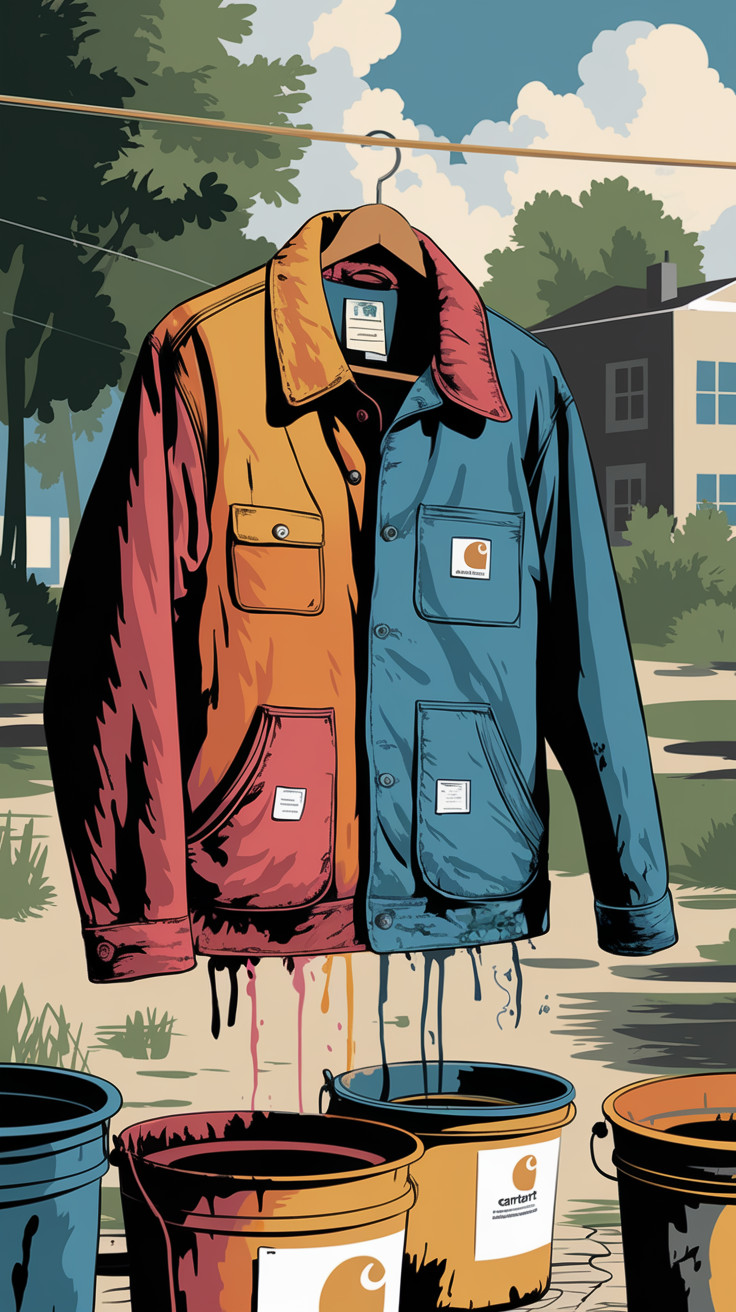Dyeing a Carhartt jacket can breathe new life into an old favorite or personalize a new purchase. These jackets are known for their durability and can handle a dyeing process when done correctly. To successfully dye a Carhartt jacket, use all-purpose fabric dyes that effectively change its color.
When choosing a dye, consider the material of your jacket. Many Carhartt jackets are made from cotton canvas, which absorbs dye well. Synthetic fibers may not take dye as effectively, so it’s important to know the fabric composition of your jacket before starting the project.
Preparing the jacket properly is crucial. Clean the jacket thoroughly and follow the dye package instructions for the best results. This process will not only refresh or customize the jacket but also ensure its longevity and personal style touch.
Understanding Carhartt Jacket Fabric

Carhartt jackets are known for their durable materials. They are often made with 100% cotton canvas, which provides a tough outer layer. This type of fabric stands up to wear and tear, making it ideal for workwear. Additionally, the canvas is tightly woven, adding to its strength.
Some Carhartt jackets include synthetic fibers. These fibers offer added benefits like water resistance. While the main body might be cotton, other parts such as linings can consist of nylon or polyester. These materials provide warmth and comfort.
When considering dyeing, it’s crucial to note that different fabrics react differently to dye. Cotton absorbs dye well, making it easier to change its color. Synthetic fibers, however, can be more challenging to dye, often requiring specific dye types to achieve even color changes.
Key Features of Carhartt Jacket Fabric:
- Material: Often 100% cotton canvas
- Synthetic Fibers: Sometimes used in linings
- Durability: Resistant to abrasion
- Washability: Easy to clean but careful with dyeing
Carhartt jackets are known for their rugged design and longevity. Understanding the mix of materials used is essential when planning to dye the jacket, as each fabric type affects the final result.
Choosing the Right Dye for Your Carhartt Jacket

Choosing the right dye ensures your Carhartt jacket looks great after dyeing. Consider the fabric type and dye options suitable for it.
Types of Fabric Dyes
When dyeing a Carhartt jacket, it’s important to consider fabric dyes such as all-purpose dyes and fiber-reactive dyes. All-purpose dyes are versatile and work well on cotton and other natural fibers. They are a common choice for beginners due to their ease of use.
Fiber-reactive dyes are ideal for cotton as they create vibrant colors and resist fading. They chemically bond to the fabric, providing long-lasting results. It’s important to follow instructions carefully to ensure even coverage and the desired intensity of color.
Compatibility with Carhartt Materials
Carhartt jackets are known for durability, often made from materials like cotton canvas. Before dyeing, examine the fabric composition. Jackets with a high percentage of cotton usually respond well to most dyes.
Some Carhartt jackets have blends involving synthetic fibers. These might not dye uniformly with standard fabric dyes. In such cases, consider a dye specific for synthetics, but note the limitations in color change. Always perform a patch test on a small, inconspicuous area first.
Understanding the material structure can prevent ineffective dye jobs and lead to a satisfying transformation.
Preparation for Dyeing Your Jacket
Before dyeing a Carhartt jacket, it’s important to thoroughly clean the jacket and set up the work area. Ensuring the jacket is free from dirt and oils will help the dye adhere more effectively. Arranging a proper workspace minimizes mess and allows for easy application of the dye.
Cleaning the Jacket
Cleaning the jacket is the first essential step. Pre-wash the jacket using a mild detergent to remove any dirt, oil, or residue. Avoid using a fabric softener during this wash, as it can interfere with the dye’s ability to bond to the fabric.
After washing, examine the jacket to ensure it’s thoroughly clean. Pay special attention to areas like the cuffs or collar, where grime might linger.
Let the jacket air dry completely. This ensures that the water doesn’t dilute the dye in the next process. A clean, dry jacket will soak up the color more evenly, providing a more vibrant result.
Setting Up the Work Area
Setting up the workspace is crucial for a smooth dyeing process. Choose a well-ventilated area, ideally with access to water, in case of spills. Cover surfaces with old towels or plastic sheets to protect against stains.
Gather all necessary equipment before starting. This includes gloves, measuring cups, and the dye solution. Having everything within reach allows for a more organized process and less rushing around during dyeing.
Ensure the dye and any accompanying substances like salt or dish soap are ready. Lay these out in a logical order so everything flows smoothly during application. Proper preparation helps in achieving a consistent dye job across the jacket.
Dyeing Process

Dyeing a Carhartt jacket involves careful preparation and execution. Mixing the dye correctly ensures even color, applying it thoroughly gives consistent results, and setting the dye makes it last longer. Each step is key to achieving the desired look.
Mixing the Dye
Mixing dye properly is essential for a vibrant and uniform color. Start by selecting a quality fabric dye, such as Rit Dye. It’s important to read the instructions on the package carefully to determine the correct ratio of dye to water. For a full jacket, you might need about half a bottle of liquid dye or a similar amount of powder dye.
To prepare the dye bath, use a large basin or bucket. Fill it with hot water, as this helps the dye adhere to the fabric. Make sure the container is big enough to fully submerge your jacket. Dissolve the dye completely in the water, stirring thoroughly to eliminate clumps. Depending on the dye, adding salt or vinegar can help set the color more effectively.
Applying the Dye
Once the dye is mixed, it’s time to apply it to the jacket. Pre-wet the Carhartt jacket, as this allows the dye to saturate the fabric more evenly. Submerge the jacket in the dye bath, ensuring it is fully covered. Use gloved hands or a stick to move the jacket around in the dye for even coverage.
Let the jacket sit in the dye for the recommended time on the label. For a deeper color, the jacket can often be left longer, but be cautious of excess dye as it may bleed later. Regularly stir and reposition the jacket to prevent uneven patches or streaks.
Setting the Dye
After applying the dye, setting it correctly ensures that the color remains vibrant and doesn’t fade quickly. Rinse the Carhartt jacket in cold water until the excess dye stops running. This helps lock in the color and prevents it from bleeding in future washes.
Next, wash the jacket in mild detergent using a gentle cycle. Adding a cup of white vinegar during the rinse cycle can further help in setting the dye. Once cleaned, hang the jacket to air dry, avoiding direct sunlight to prevent fading.
Rinsing and Washing Post-Dye

After dyeing a Carhartt jacket, it is important to properly rinse and wash it to ensure the dye sets well and excess color is removed. These steps help maintain the jacket’s quality and prevent bleeding onto other fabrics during future washes or wear.
Removing Excess Dye
Once the dyeing process is complete, it’s crucial to remove any excess dye. Start by thoroughly rinsing the jacket in cold water. This helps to wash away loose dye particles. Rinse continuously until the water runs clear.
Using gloves during this stage can protect hands from becoming stained. It might take several rinses to reach the desired result, so patience is key. Don’t rush this step. It’s vital for ensuring a clean finish and long-lasting color.
Final Rinse and Wash
After removing the excess dye, a final cold water rinse is necessary. Follow up with a mild detergent wash using warm water. This step helps secure the dye in the fabric fibers and provides a professional finish without causing fabric damage.
Be sure to wash the jacket separately for the first few times, as some dye might still bleed. Once completed, check the color for evenness. This ensures that the jacket is now ready for wear without worry of dye transfer.
Maintaining Your Newly Dyed Carhartt Jacket

Keeping your newly dyed Carhartt jacket looking vibrant involves careful washing and proper storage practices. These steps will help protect the color and extend the life of your jacket.
Ongoing Care Tips
For routine care, wash the jacket in cold water. Cold water helps preserve the dye, reducing fading. Use a mild detergent to avoid harsh chemicals that might weaken fibers or strip away the color. Avoid bleach as it can significantly alter the dye.
Consider air drying the jacket to maintain its shape and color. Machine dryers can cause colors to fade faster due to heat and friction. If necessary, use a low heat setting.
Spot clean any stains promptly. Use a damp cloth and mild soap to clean the area, rinsing thoroughly afterward. Avoid scrubbing aggressively as it might remove the dye in that spot.
Storing Your Carhartt Jacket
Store the jacket in a cool, dry place away from direct sunlight. Sunlight can cause the dyed colors to fade unevenly over time. Hang the jacket using a sturdy hanger to avoid creases that can set over time.
When not in use for an extended period, consider using a garment bag for extra protection against dust and moisture. Ensure the jacket is clean and fully dried before storing to prevent mold and mildew.
By following these storage tips, the jacket will be ready for future wear without losing its newly acquired color.









